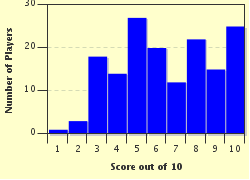Quiz Answer Key and Fun Facts
1. Technically, twilight is both the time between daylight and dark AND the time between dark and daylight.
2. At twilight, where is the sun typically located in relation to the horizon?
3. "Crepuscular" is derived from a Latin word meaning "twilight." It indicates certain animals that are most active during the twilight hours. Which of the following would NOT be considered crepuscular?
4. There are three degrees of twilight. What degree of twilight is defined as the sun being less than six degrees below the horizon providing sufficient light that additional illumination (such as a flashlight) is not required?
5. What degree of twilight is defined as the time when the sun is between six- and twelve-degrees below the horizon and the horizon is no longer a suitable point of reference?
6. What degree of twilight is defined as the time when the sun is between twelve and eighteen-degrees below the horizon, during which time visible "sunlight" may be indistinguishable to the naked eye?
7. At the poles, twilight during the winter months is very short.
8. Which of these cities, while they don't quite have all night "twilight," do have lighter skies, sometimes called "white nights"?
9. Through a 24-hour day during a summer solstice at more than 73° latitude, how can the sun be described?
10. At the Earth's poles, how many times does the sun rise and set over the course of a year?
Source: Author
TemptressToo
This quiz was reviewed by FunTrivia editor
WesleyCrusher before going online.
Any errors found in FunTrivia content are routinely corrected through our feedback system.


